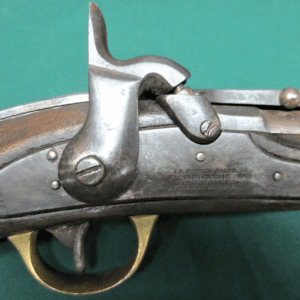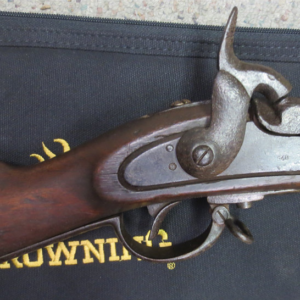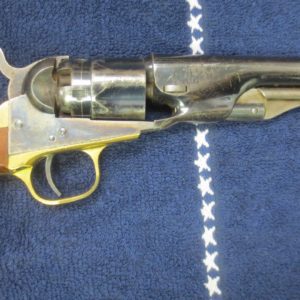Description
This scarce example surfaced in an estate sale in West Virginia only a few weeks ago and is one of only a few dozen which have yet to be discovered! The weapon is totally devoid of any markings except for Belgian export barrel proof markings and this one no doubt found its way to the US via US importation or the Blockade circa 1861. At some point, not recent times, the gun was cleaned to armory bright. The wood is typical European grade poplar or pine and is free of cracks or major defects other than one section on the forearm that very much looks like a large caliber bullet graze! If this one could talk, what a story could be told!
The Belgian and French makers were a traditional source for additional British military arms produced during periods of need greater than could be accommodated by the London and Birmingham makers. With the advent of the Crimean War, the British Government turned to the Paris and Liège trade to supplement the manufacturing capabilities of their domestic gunmakers. The first Belgian contract for P-1853 Enfield Rifle Muskets was for 20,000 stands of arms and commenced on October 31, 1854 and the arms were to be delivered by May 31 of the following year. With the ending of the war in February of 1856, the critical need for arms was temporarily alleviated, but the British War Department still let an additional contract for 5,000 more P-1853s from Liège in June of 1859. By the time the American Civil War erupted in April of 1861, the Belgian trade had several years of experience in the production of the most advanced and widely used muzzle loading military rifle musket in the world, and were tooled up to produce the pattern in quantity.
The European makers found a lucrative market for P-1853s with the American combatants beginning in 1861. Many of the brokers who purchased thousands of continental arms for the US and Confederate governments purchased Belgian made Enfields along with a wide array of surplus arms from Austria, Prussia and France. While it is unclear how many European (non-English) P-1853 rifle muskets were purchased by the combatants during the conflict, it is quite clear that they were. It is also quite clear that the British gun trade had long relied upon Belgian makers to supplement their output and it is quite likely that a large number of the Enfields delivered on British contracts to the North and South included Belgian and French manufactured arms and even more arms with Belgian and French made components. The makers of the European trade would often produce complete arms that were almost completely unmarked externally, allowing the purchaser to mark them as if they were their own product or to conceal the origin of the arms. This proclivity sometimes makes the recognition of European produced arms somewhat difficult.
This P-1853 Enfield Rifle Musket is a nice example of one of those European made weapons. The gun is in an very nice state of preservation and fully operational. The lock shows the typical double boarder line engraving found on most Birmingham and some London contractor produced Enfields and even the ramrod is of the typical knurled and slotted English type.
If you like arms that are relatively rare with a high chance of being Confederate used, this one is for YOU! For reference, an identical pattern of this weapon was sold by dealer Dave Taylor of Ohio not long ago…the only difference? The price.
“17-08-20… Extremely Rare French Contract P-1853 Enfield Rifle Musket: In the forty five years I have collected and traded antique guns, this is the first of these unsigned French Enfields I have owned. Classic P1853 Enfield in overall VG ++ condition. The barrel has many interesting proof marks including a cartouched “D” flanked by two five pointed stars, a crown over P, and letter D inside a vertical oval. A truly top quality contract piece made in France under contract. Rear sight has a crown over F. The underside of the stock is stamped RV in front of the trigger guard tang. 100% original, 100% complete, and mechanically perfect. These French Enfields were used in the Crimean War (1854-1856), and with France’s close ties to the Confederacy they have a Southern connection as well. A very solid Enfield and darn scarce … $1,950.00 sold”









